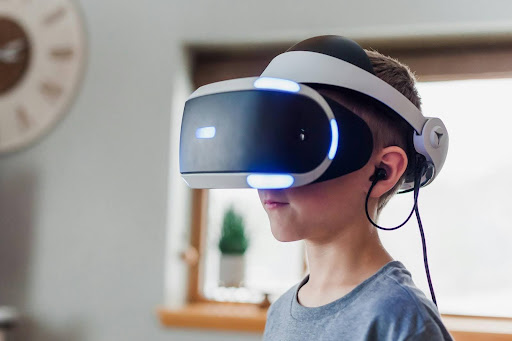Implementing augmented reality (AR) and virtual reality (VR) into education is now an option for the average household, transforming how parents home-school their children. Here is an overview of how these technologies may revolutionize alternative education.
Why Use AR and VR for Home-Schooling?
Flexibility is among the most significant benefits of AR and VR, allowing you to utilize a phone, tablet, headset or computer. Although top-of-the-line equipment may improve learning outcomes and be more fun, the basics are accessible to any home-schooler.
In standard classrooms, students are subject to the same slideshows, homework and tests. AR and VR are different — they personalize education. Even if students are in the same virtual environment, their experiences remain individualized because of their unique interactions.
AR and VR can even positively affect memory. In one study, the VR group retained 92% of the learning material — much higher than the other group’s 76% retention rate, suggesting students are more likely to remember immersive and engaging lessons over text-based materials.
“Between 2019 and 2022, the number of home-schooled students increased from 2.5 million people to 3.1 million.”
How to Use AR and VR for Home-Schooling
More people are flocking to home-schooling than ever before. Between 2019 and 2022, the number of home-schooled students increased from 2.5 million people to 3.1 million. AR and VR use cases will expand as they become more popular.
AR Use Cases
AR technology gamifies learning — meaning it introduces game mechanics. You could use it for home-based learning by introducing scoring, progression or competitive elements into the curriculum. For instance, you could turn tests into boss battles, rewarding learners with avatar customization items or points if they do well.
Home-schooled students can study virtually every subject with AR, whether they take music, physical education or science classes. An example would be displaying an augmented graphic of sheet music, an agility ladder or human DNA to give them something to interact with.
VR Use Cases
VR technology lets home-schooled students immerse themselves in a virtual environment. You could take advantage of this feature by simulating memorable experiences for them, such as visiting the Egyptian pyramids, exploring the solar system or watching the tectonic plates in action.
Regarding simulation, VR also lets home-schooled students get hands-on experience in realistic environments. It allows them to play instruments in an orchestra, dissect a frog humanely or stand at the edge of a volcano eruption. No matter the subject, they will learn better when they apply their knowledge in real time.
“Research shows VR improves students’ academic performance and lessens their mental workload.”
Are AR and VR Effective Learning Tools?
Numerous studies have shown AR and VR are excellent tools for learning. While the conversation about their educational benefits mainly concerns public schools, the same concepts apply to home-schooling.
AR’s Effectiveness in Education
Since AR keeps students grounded in reality while they learn, it increases engagement and attentiveness. Research shows it improves students’ academic performance and lessens their mental workload, proving more effective than similar technologies or media forms.
VR’s Effectiveness in Education
VR has an exceptional impact on learning by positively impacting educational development for K-6 students, regardless of the subject area. According to research, it is more effective than computers and semi-immersive technology.
What Makes AR and VR Revolutionary?
Students who learn using AR and VR are more likely to be engaged and interested in the subject matter. Instead of sitting through hours of lectures, they connect with the learning material meaningfully, opening doors to new experiences they would not have otherwise.
One of the most revolutionary aspects of AR and VR is their interactivity. Unlike distance education or traditional home-schooling — where students connect over a monitor or not at all — they meet in virtual spaces.
Few other technologies allow them to interact with the world through touch, zoom and rotating elements in the virtual environment. These hands-on experiences translate exceptionally well to an educational space.
While computers, tablets and smartboards make education fun, students must still sit in one place. AR and VR are revolutionary because they enable physical movement — and an active lifestyle contributes to a well-rounded education and better learning outcomes.
“VR learning is 3.75 times faster than classroom learning and nearly twice as fast as e-learning.”
Since VR learning is 3.75 times faster than classroom learning — and nearly twice as fast as e-learning — it increases students’ chances of achieving higher scores and better retention.
Another revolutionary aspect of AR and VR involves creativity. You can create, share and occupy virtual environments. Whether you design a whimsical museum or a physics-bending playground, your only limitation is your imagination. It inspires ingenuity, encourages exploration and makes learning fun.
How to Source AR and VR Equipment
There are multiple ways to source AR and VR equipment for home-schooling. Here are five ways to obtain these resources.
-
Find Grants and Programs
Various companies and federal agencies offer learning grants for home-schoolers, some of which provide funds for AR or VR implementation. While finding and applying to them is time-consuming — and success isn’t guaranteed — it could be worth the effort.
-
Source Affordable Alternatives
The average VR headset costs about $427 in 2024 and will only drop $3.34 by 2028. If you cannot afford a higher-end model, consider more affordable alternatives. Cardboard headsets may be less fun or practical, but they do the job.
The same concept applies to learning materials — AR and VR have countless free or reasonably-priced educational apps available. Use the affordable resources available if you cannot afford to build your own or use a quality program.
-
Partner With Local Groups
If you start or join a local home-schoolers group, you can ask everyone to pitch in funds to lower costs. While this approach takes more effort than others, it can be beneficial in finding other virtual classmates.
-
Get Equipment Second-Hand
AR and VR technology have existed for a long time, so older models are now reasonably priced. If the price tags are still too high, consider sourcing your equipment second-hand through online swaps or thrift stores.
-
Consider Special Accessories
Remember, you might need additional equipment — like controllers or gloves — for some use cases. Considering how 23.1% of parents say they home-school because their child has a disability, accessibility accessories might also be a significant consideration.
The Transformative Power of AR and VR
AR and VR have the potential to transform homeschooling permanently. Soon, it could turn from a solitary experience into a collaborative, immersive one. You will probably see the day when every home-schooler has a headset before long.









